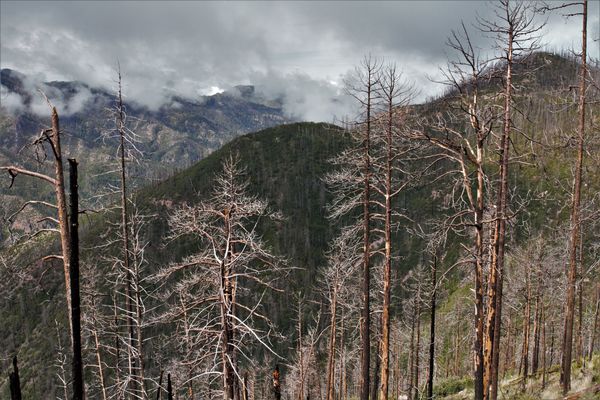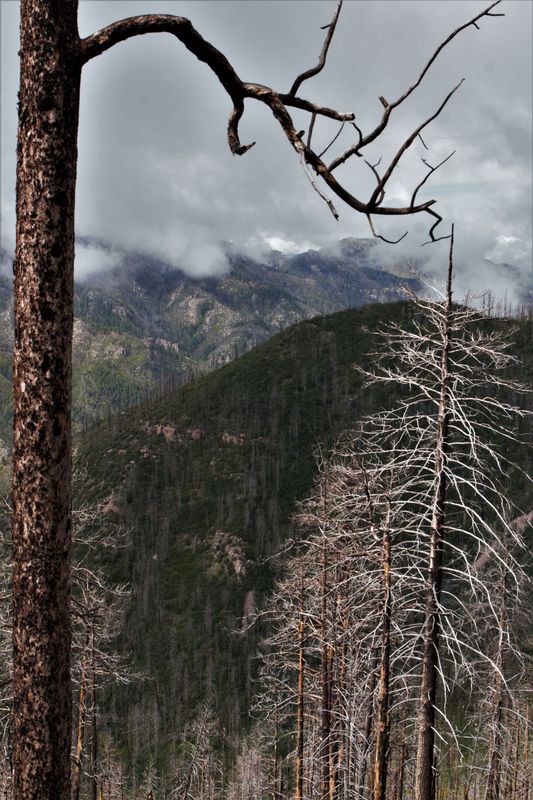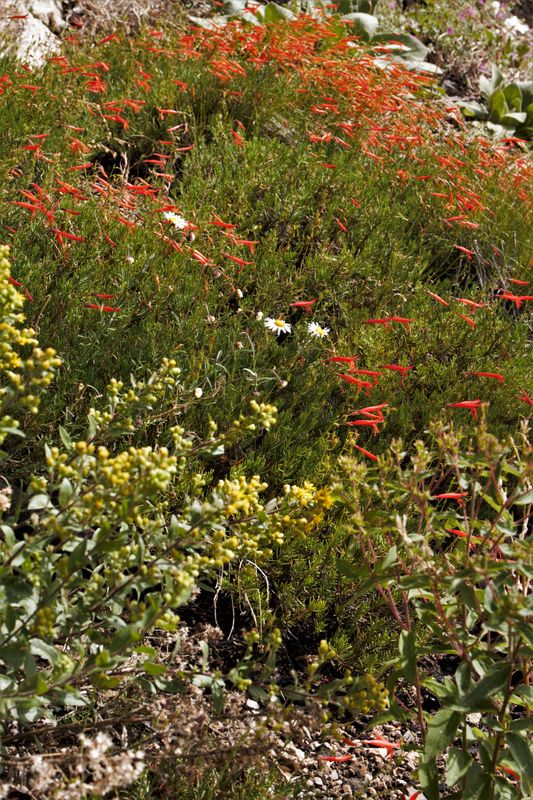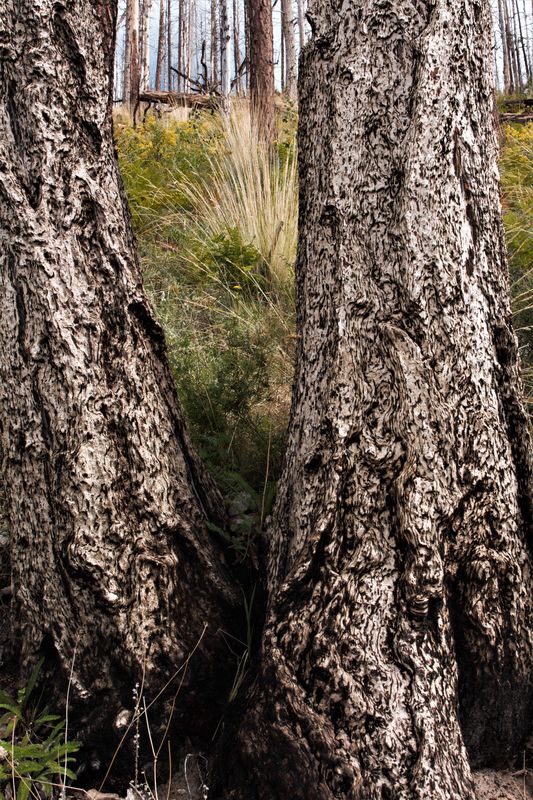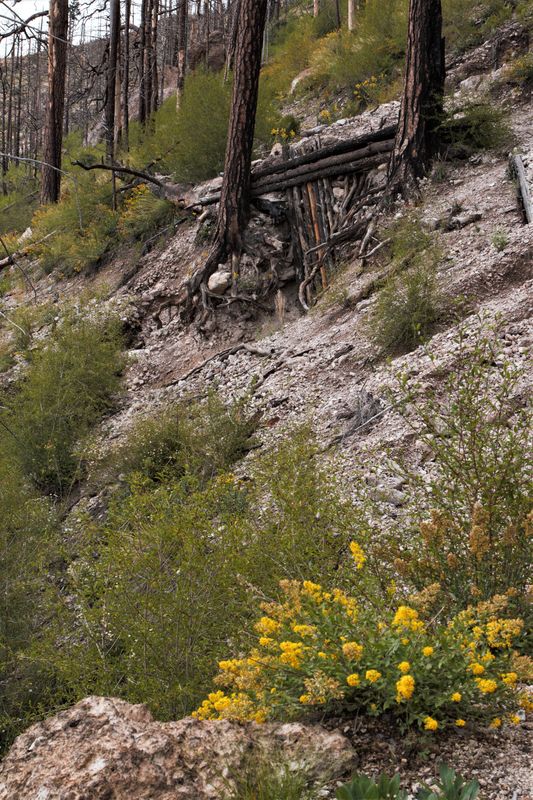Hike through a fire-scarred landscape
Sep 24, 2018 20:29:59 #
SWFeral
Loc: SWNM
The Whitewater/Baldy Complex Fire was the largest wildfire in New Mexico's admittedly brief history; the state turned 100 while the fire raged. It burned just under 300,000 acres in the Gila National Forest, much of it in wilderness. Of course by now other western states have seen far more devastating wildfires, but this one was hard for us down here in this corner of the state. An estimated 200 miles of the trail system was lost, and nearly all the "relic forest"--old-growth stands of Douglas fir and Englemann spruce at 10,000 feet and above--leaving the mountaintops parched and exposed, no longer to generate weather from the moisture in the forest and no longer able to hold onto what little snow pack now exists. This past winter virtually no snow fell and what did melted because of the intense sun.
It wasn't a beneficial fire that burned in a mosaic pattern; it pretty much wiped out the best parts of 465 square miles. The ash from runoff the following year killed most of the fish in affected streams, the benefit being that native trout could be re-introduced with little competition from non-native species. Another benefit, if I have to scrounge for one, is that the wildflowers have gone nuts with all the sunlight they now have. Others have vanished, however, notably the beautiful Calypso Fairyslipper Orchids I used to see in the deep shade near a spring. Bizarrely, the remains of a notoriously nasty plane crash strewn all over a mountainside melted and ran across the deep ashes that covered the Mogollon Crest Trail, solidifying into elongated blobs (I have two such blobs on my computer desk).
These photos were made on the Redstone Park Trail, once a beautiful, if very steep and switchbacky, descent five miles down to the beautiful Whitewater Creek. Before the fire it was hard to get a good view of the surrounding countryside because the trees were so dense. The woods were so dark and covered in moss that I found them rather spooky back then. Now the views are endless with nothing in the way. After the fire was out, which took two months, parts of the scar were strewn with straw and seeded with annual rye grass, something that would grow tall quickly and then lie down and protect the bare ground from erosion. Others, like this trail, just received straw. My first visit was five months after the fire, in December of 2012. I hiked the steep ascent through a brief stretch of intact forest, topped the ridge, and felt devastated. There was no green whatsoever, just the black of the burnt tree trunks, the grey of ash, and the glaring white of the straw. The wind blowing through those naked trees sounded like ghosts moaning through broken windows. The experience was so grating that I did not attempt more than a few hundred yards of the trail.
As you can see, beauty is now returning, though not the same beauty. Those fir and spruce forests will never come back. Aspen trees are filling in, which is nice, but also scrubby oak and the hideous and thorny New Mexico Locust. On the day I was there, a fog that had settled in during the night was lifting, giving the eerie sense that the fire was still smoldering.
[As if that fire hadn't been bad enough, the following year another wildfire of equal intensity charred another 136,000 acres in the Aldo Leopold Wilderness east of here.] Thank you for your interest.
It wasn't a beneficial fire that burned in a mosaic pattern; it pretty much wiped out the best parts of 465 square miles. The ash from runoff the following year killed most of the fish in affected streams, the benefit being that native trout could be re-introduced with little competition from non-native species. Another benefit, if I have to scrounge for one, is that the wildflowers have gone nuts with all the sunlight they now have. Others have vanished, however, notably the beautiful Calypso Fairyslipper Orchids I used to see in the deep shade near a spring. Bizarrely, the remains of a notoriously nasty plane crash strewn all over a mountainside melted and ran across the deep ashes that covered the Mogollon Crest Trail, solidifying into elongated blobs (I have two such blobs on my computer desk).
These photos were made on the Redstone Park Trail, once a beautiful, if very steep and switchbacky, descent five miles down to the beautiful Whitewater Creek. Before the fire it was hard to get a good view of the surrounding countryside because the trees were so dense. The woods were so dark and covered in moss that I found them rather spooky back then. Now the views are endless with nothing in the way. After the fire was out, which took two months, parts of the scar were strewn with straw and seeded with annual rye grass, something that would grow tall quickly and then lie down and protect the bare ground from erosion. Others, like this trail, just received straw. My first visit was five months after the fire, in December of 2012. I hiked the steep ascent through a brief stretch of intact forest, topped the ridge, and felt devastated. There was no green whatsoever, just the black of the burnt tree trunks, the grey of ash, and the glaring white of the straw. The wind blowing through those naked trees sounded like ghosts moaning through broken windows. The experience was so grating that I did not attempt more than a few hundred yards of the trail.
As you can see, beauty is now returning, though not the same beauty. Those fir and spruce forests will never come back. Aspen trees are filling in, which is nice, but also scrubby oak and the hideous and thorny New Mexico Locust. On the day I was there, a fog that had settled in during the night was lifting, giving the eerie sense that the fire was still smoldering.
[As if that fire hadn't been bad enough, the following year another wildfire of equal intensity charred another 136,000 acres in the Aldo Leopold Wilderness east of here.] Thank you for your interest.
Sep 24, 2018 20:39:00 #
Nice series of photos showing the devastation that fire does to our wilderness. Your description of the loss of your nature area is very heart broken. The loss of trees, orchids and other plants is extremely sad. Mahalo for your historical description and photos is greatly appreciated.
Sep 24, 2018 20:57:37 #
SWFeral
Loc: SWNM
Thank you. I could have written pages but tried to keep my emotions in check. And anyway, no one would have read all that. Even six years after the fire, I am still at times unable to believe all that was lost.
Sep 24, 2018 21:54:53 #
Sep 24, 2018 22:34:58 #
SWFeral
Loc: SWNM
NMGal wrote:
Have any animals or creepy crawlers returned?
Oh I think a lot of them did. During the fire we heard a lot of sad stories, like the three bear cubs overcome by toxic gases when the fire traveled something like 4500 feet in 90 seconds--who could outrun that? But animals of course are more attuned to natural disasters than we are, and they had to know something very bad was happening. Yet I think many perished. Of course most people think only of human lives lost, and there was one, an elderly man who drowned in a subsequent flood. But for us the loss of beautiful, peaceful places to go to find serenity was huge. We can never get those places back. Plus there was a life-changing effect on some local economies that depended on tourism. You live in this state; you're no stranger to wildfires. Thanks for your interest.
Sep 25, 2018 07:15:28 #
SWFeral wrote:
The Whitewater/Baldy Complex Fire was the largest ... (show quote)
I think a comprehensive forest management plan could eliminate a lot of the devastation.
Sep 25, 2018 11:34:04 #
I remember that fire. I have friends who have (had) a place in the Gila. It was a lovely place to go visit, camp, and explore. It reminds me of the remains of our Rodeo-Chedisky fire. It's still coming back. We lost a LOT of old growth.
Sep 25, 2018 15:11:51 #
Wonderful post! Great photography and history with a good overview of the area.
Sep 25, 2018 16:08:36 #
wayne barnett
Loc: Grants Pass, Oregon
We have similar issues in Oregon. Large areas are burned each year. As was noted a comprehensive forestry plan would help. We (the white man) started suppressing forest fires over 100 years ago. This is one of the prices we pay.
Sep 25, 2018 16:23:14 #
wayne barnett wrote:
We have similar issues in Oregon. Large areas are burned each year. As was noted a comprehensive forestry plan would help. We (the white man) started suppressing forest fires over 100 years ago. This is one of the prices we pay.
I guess the color of your skin is to blame?? Why?? You mean the color of your skin means you are ignorant and stupid??
Sep 25, 2018 22:24:13 #
SWFeral
Loc: SWNM
traderjohn wrote:
I think a comprehensive forest management plan could eliminate a lot of the devastation.
The Gila National Forest has actually been fairly progressive when it comes to prescribed burning and letting wildfires burn. But it's true that a century of fire suppression and the fact that no significant fires had burned naturally in this area for a long time, along with hot, dry, and windy conditions, created the perfect storm that allowed this monster to thrive. It started as a lightning strike in a very remote and rugged part of the wilderness, and I think the idea was to let it do its thing. All well and good until a second lightning strike a few miles a way, maybe more, started another fire, and a week later the two fires merged.
Sep 25, 2018 22:28:25 #
SWFeral
Loc: SWNM
AzPicLady wrote:
I remember that fire. I have friends who have (had) a place in the Gila. It was a lovely place to go visit, camp, and explore. It reminds me of the remains of our Rodeo-Chedisky fire. It's still coming back. We lost a LOT of old growth.
I remember the Rodeo-Chedisky fire too, and of course the Wallow Fire. Seems they were both human-caused, one intentionally so, which makes the tragedy even greater. Those were huge fires, much larger than the one I described. Did your friends lose their spot in the Gila?
Sep 25, 2018 22:33:50 #
SWFeral
Loc: SWNM
UTMike wrote:
Wonderful post! Great photography and history with a good overview of the area.
Thank you. Since my great passion is the Gila, it's important to me to share what goes on with it. That fire, combined with the Silver Fire the following year, changed the lifestyle of many people. I know people who simply stopped going to the forest, unable to deal with the loss. To me that's like not visiting a badly injured friend or family member in the hospital, but everyone's got their limits. I have pushed myself to visit the ruined areas, but also to find new, intact areas to explore.
Sep 25, 2018 22:39:26 #
SWFeral wrote:
I remember the Rodeo-Chedisky fire too, and of course the Wallow Fire. Seems they were both human-caused, one intentionally so, which makes the tragedy even greater. Those were huge fires, much larger than the one I described. Did your friends lose their spot in the Gila?
I believe they did. I lost contact with them sometime after.
Sep 25, 2018 22:40:20 #
SWFeral
Loc: SWNM
wayne barnett wrote:
We have similar issues in Oregon. Large areas are burned each year. As was noted a comprehensive forestry plan would help. We (the white man) started suppressing forest fires over 100 years ago. This is one of the prices we pay.
We are starting to learn from our mistakes--perhaps too little, too late--but the loss is great. Now every time I read about a prescribed burn I silently cheer even as I cross my fingers and hope it doesn't blow up out of control. I remember hiking down that trail well before the fire, having to climb over huge fallen trees and noticing the jungle-like tangle of the forest. I wondered to myself, "God, what would happen if a fire came through here?" but assured myself it was too damp for a fire to do much. That was before everything dried out from years of drought and became a tinderbox. And now I know what would happen if a fire came through.
If you want to reply, then register here. Registration is free and your account is created instantly, so you can post right away.
